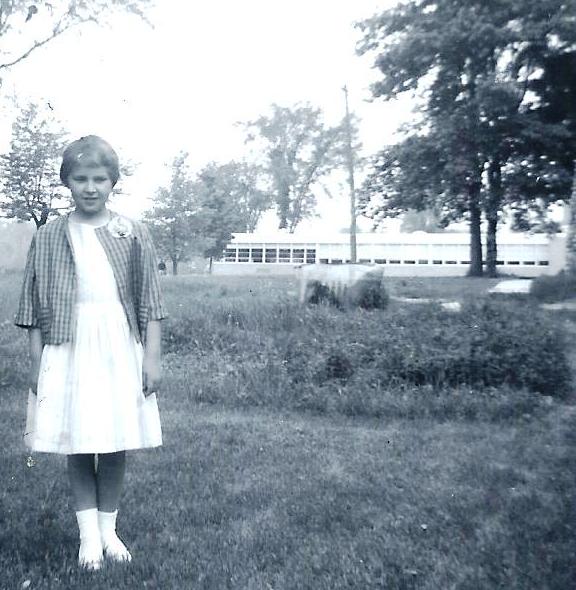
In the summer of 1958 Fred and Jane Ettawageshik and their two grade-school age sons, Frank and Tim, rented the Turner house next door to us, on the corner of Main and Blevins Streets. The Ettawageshik family came to Marion from Harbor Springs. Mrs. Geshik, as she was called by her students, taught English composition and grammar and eventually French at the Marion High School, just across Main Street.
The boys found, just as we all did on Blevins, that the many flowing wells along our street were a great source of entertainment to a kid, summer and winter. Frank and Tim quickly became expert at mixing mud and ditching overflow. They also learned the fine art of “icing” snowballs when the snow flew.
There was a fine flow in the Turner yard. It ran from a pipe in the ground, making its way, like a miniature river, toward the swamp behind us. At some point that summer Gerald Turner installed a big metal tank and “stocked” it with quite a supply of respectable sized fish. The well gave them a constant supply of flowing water to tend to their oxygen needs. They relied on Gerald for meals and they got snacks from the Blevins Street kids, once we discovered them.
All the kids on Blevins Street were taken with that tank of fish. It became a regular gathering spot. We all liked to watch the smaller fish swim in circles. The larger ones stayed on the bottom. Soon enough someone discovered that if the tank was hit sharply the loud noise would freak the fish and they would dart in the opposite direction. The fish, being smarter than we gave them credit for, soon realized they had nowhere to go and got used to the aggravation. We landscaped the bottom of the tank with rocks, in part because we liked the ker-plop-ker-plunk noises the rocks made when dropped in the water. And because we foolishly thought we could drop a rock on an unsuspecting fish.
I don’t know where Gerald got these fish or why he kept them in the tank. There were perch and bluegill most certainly, and probably respectable sized bass. As the summer wore on they grew and became immune to the noise and the little faces peering at them. Or they were just numb from the very cold water.
One sleepy afternoon, the thought struck us that perhaps we could catch these fish. After all, what else did they have to do but eat? We sought and received permission to try our hand at fishing in the flowing well. We rounded up our poles, for every kid had a fishing pole, and dug worms in the garden. We baited our hooks and plopped the lines into the tank. We were sure we would be bragging about the big ones we’d catch before dinner time. No such luck. The fish wouldn’t bite no matter what tricks we tried, and try we did.
We plunked those juicy worms right under their noses. We made those worms dance. The fish barely moved a fin. We jigged the line. Nothing. We re-baited and tried all the secret things that we thought might work like dunking the worms in Kool-Aid, spitting on them (an old Marionite once assured us that trick would work every time) and even the ever popular wad of bubble gum. Frank even tried kernels of corn, all to no avail.
Sometime late in the afternoon, we decided that if anyone was going to have fish for supper we had better try new tactics. Frank thought that perhaps, in the Indian tradition, we could catch fish with our bare hands, or ‘noodle’ them. We put aside our poles and plunged our arms into the tank up to our shoulders. This only got us extremely cold arms and sent the fish to the opposite corner.
Time for Plan B; it was a sure thing. We headed for our respective garages for fish nets. The Ettawageshik boys retrieved theirs and our garage provided me with a regulation trout type net and a long handled smelt net. Sue used the short net.
Results at last! This was literally like shooting fish in a barrel. Sue scooped out one she had her eye on and was off down Blevins Street with it over her shoulder. Frank and Tim dipped out their choices and headed in to show off their “catch”. I had some difficulty with the long handled smelt net, but managed to do likewise.
We all expected to be congratulated on our ingenuity. We were not. Before any of us could begin to protest, we were back at the tank practicing the parentally enforced version of catch and release. Mr. Ettawageshik explained that it was one thing to catch the fish with a pole and bait and quite another to snatch it out of a tank with a net; the fish had to have as fair a chance as it could under the circumstances. We could continue to try and catch the fish by standard means, but there would be no netting. He knew that the fish would never bite on our hooks.
We did not and fishing the flowing well gave us endless hours of summer amusement, even though we caught none. Gerald Turner’s fish went to a proper body of water where they were released. The season was over. We learned a lesson in fair play that summer. After all, sportsmanship has to be learned at every opportunity, even over a galvanized fish tank at the flowing well.
I’ve told this story before, in various forms. It’s a good one and did indeed teach me a lesson in fair play, applicable in many ways. Until now I’ve never located a photo of said tank, and wasn’t sure I had until I scanned and enlarged this photo. Titled, ‘last day of school, May 27, 1960’. It’s in the background.
